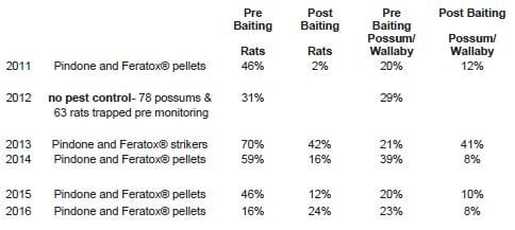Working bees to check and clear the bait lines commenced again in May and a good start was made in preparation for the actual pest control. Our first working bees to put out the rat bait were on 21st and 22nd July.
Last year, baffles were fitted to the Philproof bait stations and proved to be very successful in preventing possums taking the bait intended for the rats.
Consequently the amount of Pindone required was greatly reduced. This year, alternate lines will have Romark bait stations for the Feratox® (cyanide) and the results will be compared to the Feratox® bio bags used on the other lines.
Dave Edwards, who designed and trialed the baffles used last year, has been investigating using the Romark stations and his trials and videos have shown that if the Romarks are 250 -275mm from the ground, possums have no trouble lifting the lid on the stations and getting the bait, but rats end up sitting on the lid and so are unable to open it. . Many thanks to Dave for sharing his findings with us and to Mike Goodwin for installing all the Romark stations.
Monthly checks have been done on the Nature and Mistletoe tracks and any trimming or clearance of windfalls attended to. The Good Nature traps have also been checked monthly and any kills or counter strikes found have been recorded.
This project is dependent on volunteers and I wish to thank all those who have been involved over the past months. It is always good to have some new people involved in the project and new volunteers are most welcome. Working bees start at 9am and normally finish by 12 noon at the latest. There is a “cuppa” and something to eat when you get back to base. I would love to hear from you if you are interested in becoming involved with this project.
Tikitapu Working Bee Programme for remainder of 2019
Sunday 1st and Monday 2nd September
*Top up D Blocks and Feratox as required
Sunday 15th & Monday 16th September
*Clear stations of remaining D Block and Feratox®
* = volunteers with CSL required plus others to accompany them
Kind regards,
Frances Blakely
Ph 362 8480
email jandfblakely@gmail.com







 RSS Feed
RSS Feed
